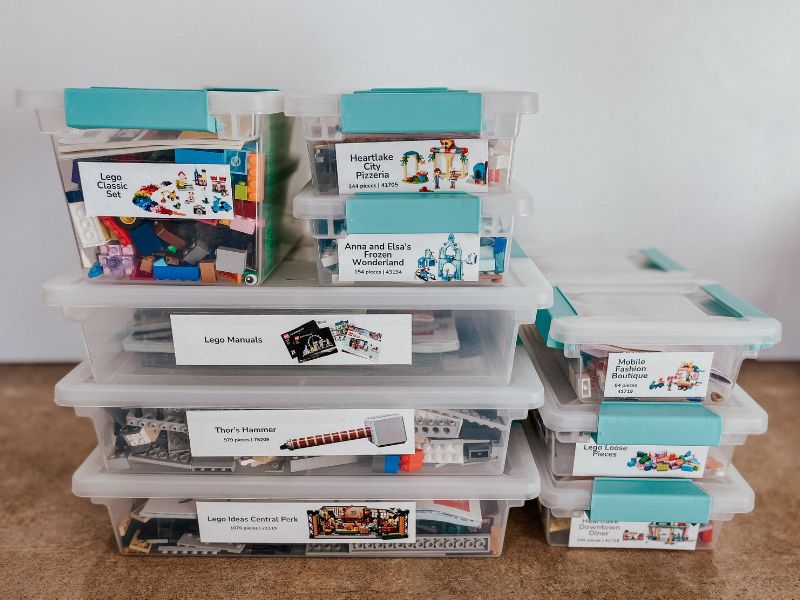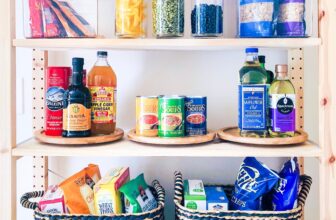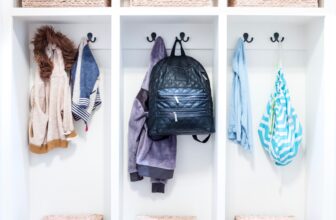How to Organize Lego Sets

I finally found the perfect way to store our growing Lego collection! Here’s how I’m organizing our Lego sets in a smaller home with no playroom and limited display space.

It’s official: our entire family is Lego obsessed. Our first grader has collected so many Lego Friends sets, David and I have been doing the Lego Architecture sets during date nights, the kids have gifted me several flower sets lately, and our toddler is already very into building with Lego.
And like any family with a quickly-growing Lego collection, I realized we needed to get a handle on organizing all of these Lego sets before they take over the whole house. I researched a ton of ideas and thought through many storage options before I settled on the best system for our family, and now it’s ready to share with you!
If you’re looking for Lego storage ideas for your kids’ Lego sets, you’re in the right place! Below I’ll share my thought process and systems to consider, along with a full tour of our Lego organization system.
What’s the best way to store legos?
There are so many factors to consider before you start organizing Legos, so here are a few things to think about before you determine a system for organizing the actual pieces along with the boxes and instructions.
- If Lego sets get built over and over again, you’ll want a plan for keeping the set together in between builds. This could either involve storing fully-built sets in bins or on storage shelves, or you could decide to disassemble sets before storing them.
- If Lego sets get built once and put on display, you’ll need plenty of display space along with a plan for storing any excess sets if you run out of room.
- If Lego sets get built once and then the pieces get used to make your own creations, you may want to store the pieces by size or different colors and not worry about keeping each set separate.
- If there are certain sets that get rebuilt a lot, you may want to keep those select few organized by set and combine all the pieces from other sets to save space and allow for more free building.
- If you plan to keep the instruction manuals, you’ll need a system for storing them either with the set they belong to or all in one central spot.
- If you plan to keep the boxes each set comes in, you’ll need to decide how and where to store those.
The way you choose to store your Legos comes down to several things: how your kids (or you) play with them, how many sets you have, the type of available storage and display space you have, and how invested you are in maintaining your Lego storage system.
Ultimately, there’s no sense in even bothering to organize your Legs if you don’t want to keep up with the system long term. One of the most important things to consider upfront is that any organization project requires maintenance, and Legos are likely going to be more work to maintain than many of the items in your house.
If you’re not prepared to keep them nicely organized, either mentally or time-wise, I’d do one of two things and call it a day: 1) get all of the loose Legos into a big bin or two and don’t worry about sorting anything, or 2) take apart completed sets and store the pieces in the original box with the manual.

This post contains affiliate links. See my disclosure policy for details.
Why I Decided to Organize Our Legos By Set
Our family loves picking out new Lego sets to build and we don’t tend to do a lot of free building, it’s mostly following the instructions from Lego exactly as designed so it made the most sense to keep ours organized into sets.
The exception to this are the Lego Duplos our three year old plays with. He loves inventing new creations by mixing pieces from different sets. I don’t expect a toddler to keep pieces neatly separated into sets, plus Duplo sets don’t have all that many pieces so it’s pretty easy to locate the pieces and rebuild them as designed if you ever wanted to. So we’re tossing all of the Duplos into one big bin and calling it a day, no sorting whatsoever.
For the rest of us, we’ve carved out some display space around the house for our completed sets. David and I’s builds are scattered about on bookshelves and dressers, and we added some open shelving to Chloe’s room to set up her growing Lego Friends city.
But I still needed a system for organizing Lego sets that haven’t been built yet or that we don’t have room to keep on display. And that’s the system I’m going to walk you through next!
Organizing Your Kids’ Lego Sets
If you’ve decided that organizing Legos by set makes the most sense for your family, here’s what I recommend doing. Megan from thehomesihavemade.com inspired this whole system FYI – her blog is a gold mine of organizing ideas!
Step 1: Round Up all Legos, Boxes & Manuals
Go around your house and gather everything Lego: the half-built sets, the unopened sets, the stray instruction books, the plastic baggie of extra pieces, any empty boxes you’ve saved, etc.
Get everything into one spot in the house so you can see what you’re working with. I’d say the only exception to this are completed sets that are currently on display – if you know they have all the pieces and you want to continue displaying them, you can let them be.
Step 2: Sort Lego Pieces Into Sets
The sorting process could be fairly quick or it could be a monstrous undertaking depending on the current state of your Legos and how many sets you own.
For us, we’re fairly new to building Legos so our collection was pretty manageable and mostly organized into sets already– either fully built or taken apart and put in baggies. The instruction manuals however were stashed all over the place so it took me a bit to locate all of those.
If you’re a big Lego family and you have bins and bins of loose Lego pieces to sort, this step may take quite a while and can be quite tedious. So just a fair warning you may want to enlist some help or have a bingeable show playing in the background while you sort.
I would start by organizing anything that’s partially or fully built – find the manual for that set and try to locate any missing pieces to complete the set. If you want to be super thorough, take each set completely apart and make sure all pieces are accounted for. Or if you’re like me and aren’t too worried about being that detailed, just go ahead and take the whole set apart.
Then move on to sets that have been completely taken apart. Use the inventory list inside the manual to gather all of the Lego bricks you need – the inventory list will note all of the brick sizes and colors as well as the number of each item. Small bowls or bins are helpful to use while sorting small parts, and plastic bags are your friend for keeping pieces together.
If you are missing any Lego manuals, you can search for pdfs of manuals onlego.com.
If you are missing any parts from a set, write down those specific pieces on a sticky note so you don’t lose track.
Note: You could, of course, store the sets fully assembled. But this requires fairly large bins and would take a lot more storage space. So I’m choosing to dismantle our sets and store the loose bricks with the manual, rather than trying to find bins to fit every fully-built Lego set. This is a better option if you have a small space.

Step 3: Organize Each set into a durable clear bin with a latching lid
First, let’s address this question: Do you keep the original Lego boxes?
As our family started accumulating Lego sets, one of my big questions was if we should keep the boxes or not. After much debate, I decided all of the original boxes would be recycled after the set is built.
My main reasoning is that Lego boxes come in so many different shapes and sizes that they aren’t really designed to stack nicely on a shelf. The boxes are also larger than necessary so there’s wasted space. Plus the boxes aren’t made to be sealed up so unless you tape them shut really well, you’ll risk pieces falling out.
The main reason I came up with for keeping the boxes is for resale. If you’re planning to build Lego sets once and then sell them, I’ve noticed that complete sets with the original boxes and manuals tend to sell faster and possibly for a little higher price on Facebook Marketplace but it seems like complete sets with manuals will also sell fine without their original boxes.
But I view Legos as one of those toys that last a lifetime and we don’t really have intentions of selling our sets any time soon. Plus, our kids are nearly four years apart so I want to hold onto sets that our youngest may want to build a few years after his older sister. So for me, it doesn’t seem worth it to hold onto a bunch of cardboard boxes.
Instead of bulky cardboard boxes, I highly recommend investing in durable containers for long term Lego storage.
You want Lego storage containers that are:
- Stackable
- Have latching lids that aren’t going to risk coming off
- Durable so they can be stacked and opened and closed often if the sets get played with a lot
- Available in various sizes to fit different sets plus their instruction manual
- Reliably easy to find in stores
- Affordable
With those criteria in mind, I went with these Sterilite plastic containers for Lego set storage. These are a great option because they come in different sizes that work well for sets of varying sizes and the sizes are all modular so you can easily stack any assortment of bin sizes. The smaller bins worked great for our smaller Lego sets and the large sizes were a great solution for our large adult sets.
I’ll link to the exact sizes I used as shown in these photos:
These storage bins also have awesome latching lids to prevent spilling all of those small pieces, and they’re sold at several retailers so I can easily grab more when we need them.
Simply fill your clear plastic bins with all of the bricks for one set, add in the Lego instruction manuals, latch the lid, and you have a great way to easily organize Lego sets!

StEP 4: Add A Label
It’s also helpful to add labels to the bins. You can make labels in a lot of different ways, but here’s a simple way to create labels using my free Canva template:
- Open my free Lego label template in Canva. You will need a free canva.com account to open and edit this. There are two labels per bin, one for the front and one for the side. You can use Lego.com to look up each set to find the name, item number, number of pieces, and an image to include on the label.
- Print the labels on regular printer paper. (You could use labels or sticker paper for this, but I wanted something that was inexpensive and easy to replicate as I need to make more of these in the future.
- Cut out the label and adhere it to the bin with clear packing tape. I put labels on two sides of my bins–one long side and one short side. This way a label will be visible no matter which direction the bins are stacked on a shelf.
I think it’s helpful to add an image to these labels to make it easy to see what a set is at a glance, especially since younger kids will be looking through these. It was really simple to download the image from Lego.com and upload that into Canva to use in my label design.
The nice part about this labeling method is that it’s not only cheap, but also easy to replicate. Since I’m sure we’ll be accumulating many new setsover the years, I wanted to make sure it would be simple to quickly make new labels as needed down the road.
Packing tape over the paper label keeps the label intact and looking nice, while still being very easy to remove if/when you need. I figured this would be better than trying to remove pesky label stickers in the future.



Step 5: Store Your Bins On A Shelf or in a Cabinet
The final step is to designate a storage spot for your Lego bins. These stack really nicely on a bookshelf or inside a storage cabinet or built-in cabinets. Find a space that works for your family and stack your new bins inside!
Keep in mind that having easy access to your Lego collection makes it more likely your family will continue to rebuild the Lego sets, so ideally your storage space is somewhere in a play area, bedroom or living space where your kids can easily get to them.
All of our kid Lego sets are currently being stored in one of the built-in cabinets by the fireplace in our living room. And then I have a couple of bins with adult sets on a bookshelf in our unfinished basement, which is also where we store our adult board games.
I hope this Lego storage idea is helpful to you! I know there are tons of ways to store Legos and lots of different scenarios, so I’d love a message from you on Instagram letting me know if you try this system or if you have another Lego storage dilemma I could possibly address in future content.
Looking for more toy organizing ideas? Take a look at these blog posts:

Have a fantastic day!








